Vienna General Hospital
The Vienna General Hospital (German: Allgemeines Krankenhaus der Stadt Wien), usually abbreviated to AKH, is the general hospital of the city of Vienna, Austria. It is also the city's university hospital, and the site of the Medical University of Vienna. It is Europe's fifth largest hospital, both by number of employees and bed capacity.

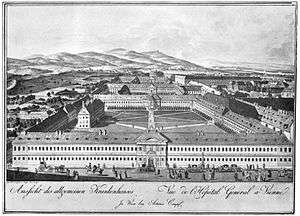
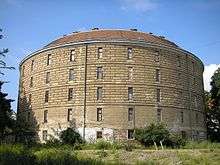
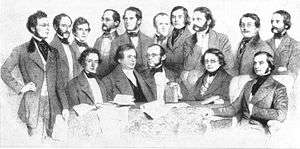
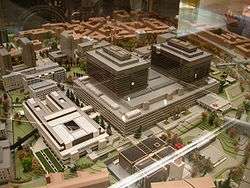
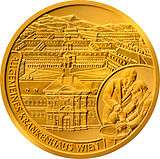
History
Old AKH
The origins of Vienna General Hospital go back to Dr. Johann Franckh, who donated properties in 1686, after the end of the second Siege of Vienna, at the corridor Schaffernack for the establishment of a military hospital. However, since money was lacking for the establishment of the buildings, the disabled veterans were quartered, including families, in the Kontumazhof (epidemic hospital), already in existence. In 1693, Emperor Leopold I arranged the establishment of the large hospital. In 1697, the first ward was finished, into which 1,042 persons were quartered.
By 1724, 1,740 persons lived there. Extension of the complex was made possible by the will of Ferdinand Baron von Thavonat, who left his estate to disabled soldiers in 1726. The marriage or widow yard, now Thavonathof, was to be finished. Also, the side yards formed by Zwischentrakte, the patient yard (4.), Restaurant economics (5.) and craftsman center (7.) were established.
During 1752 to 1774, further development occurred for the student yard (3.) and the house supervisor yard (6.). The inhabitants had to wear their own uniforms and received individual copper coins, which could be redeemed with the bakers in the complex, butchers, etc. The dissolution of the neighbouring cemetery came finally in 1834 of the 8th and 9th wards, in addition.
On January 28, 1783, Emperor Joseph II visited the poorhouse. He stated the fact that the enormous plant served more as an accommodation for people who gained entry by virtue of their connections. Those who were the neediest, were still in need of care. Professor Dr. Joseph Quarin, who later became director, used a general hospital plan.
On August 16, 1784, the opening took place. The hospital was responsible initially only for the attendance of patients; the remaining tasks of the hospitals were separate. Attached to the hospital was a maternity ward, an orphanage, and a lunatic asylum. The Narrenturm was the first special building for the accommodation of mental patients.
Particularly in the 19th century, Vienna General Hospital was the center of the Viennese Medical School, as one of the centers of medical research. Thus Ignaz Semmelweis made his observations of hygiene, and Karl Landsteiner discovered at the AKH the groups of blood types.
The site of the old AKH is used as the main university campus of the University of Vienna, and includes the university's medical institutes as well as numerous humanities institutes and several catering trade enterprises and smaller enterprises.
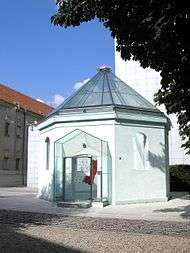
The synagogue
The synagogue in the old AKH Vienna was established in 1903 by architect Max Fleischer as the "praying pavilion" for patients of Jewish faith. The synagogue was heavily devastated during the Third Reich's Kristallnacht in 1938, and further destroyed when converted after the war, in 1953, into a transformer station.[1] In 2005, the remains of the building were restored to become the Marpe Lanefesch Memorial.[2]
The Narrenturm (Fool's Tower)
In the old AKH stands the first building worldwide for the accommodation of mental patients, established in 1784 under Emperor Joseph II by Isidore Canevale. Today, it is the seat of the Federal Pathological-Anatomical Museum, Vienna. The building consisted of a five-part fortress-like circular building with slot-like windows for 200 to 250 mental patients. In its strict geometrical form and austerity, the building is considered as a high point of the revolution classicism. Each cell had strong lattice doors and rings for chaining unrestrained patients. Ten years later, the tower was already completely outdated due to innovations in the therapy for mental patients. From its round form is derived the usual colloquial designation in Vienna, Gugelhupf, meaning a round Austrian cake. The notion that the Fool's Tower is a conversion of the idea of the Panopticon of Jeremy Bentham does not apply, since the cells are not controllable from a central observation post.
Already at the oldest model, the Fool's Tower has at the roofridge a lightning rod or a Blitzfänger. Two of its mounting plates in the inner court still exist. The apparatus, devised by the Czech priest and inventor Prokop Diviš and installed in 1754, was probably not intended as lightning protection. Josef II knew well the attempts of Diviš, which specifically concerned an assumed health benefit from currents. Whether the lightning conductors were used for the treatment of the patients has not been clarified.
New AKH
With time, the Joseph-era buildings of the general hospital became unwieldy, so in 1957, it was decided to establish a new large central hospital. The building of the new AKH was begun in the summer of 1964. At the beginning, the personnel hostels and the university clinics for child medicine were moved. In 1974, the building of the main house began. This consists of an outpatient clinic and OI area (approx. 50 OI halls) and two large, 22-floor high bed towers, which accommodate 2,200 beds.
The AKH is connected with its own underground (metro) station (U6 Michelbeuern/AKH) to the public transportation network. The Zentralbau with the bed towers was officially opened in 1994, but already partly in use from 1991. The total construction costs are equivalent, in 2004 values, to approximately 4.5 billion euro, projected as 1 billion Schilling (72.67 million euro originally). The construction costs are carried together by the city of Vienna and the Austrian federation. The cost explosion and an associated bribery affair with the building of the new AKH led to the AKH scandal, the largest Austrian building scandal. Moreover, the Austrian magazine ECO reported that only 60% of the AKH was used, and was thus planned much too large. The unused (however completely equipped) part stands completely empty.
At present, about 9,000 people are employed at the AKH. Of these, approximately 1,600 physicians and 4,500 allied health and nursing workers attend to patients. Annually, nearly 95,000 people are treated as inpatients, and another half-million attend the hospital's 384 outpatient clinics. Over 11,000 students are registered at the Medical University of Vienna.
See also
- The hospital was recently selected as a main motif for a high value collectors' coin: the Austrian €50 Ignaz Philipp Semmelweis commemorative coin. The reverse has a wide view of the old General Hospital in Vienna, where Semmelweis was stationed in the childbirth clinic.
- Hofburg - Royal court buildings during the time period.
Notes
- Feurstein, Michaela, Jüdisches Wien, Böhlau Verlag : Wien. 2001. ISBN 3-205-99094-3.
- Neugestaltung des jüdischen Bethauses am Campus University of Vienna official site
References
- Alfred Stohl, Der Narrenturm. Oder die dunkle Seite der Wissenschaft. Vienna, 2000.
- This article includes information translated from the German-Wikipedia.
External links
